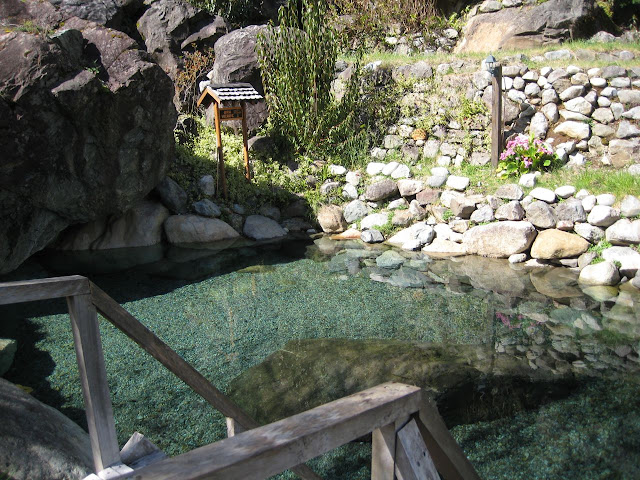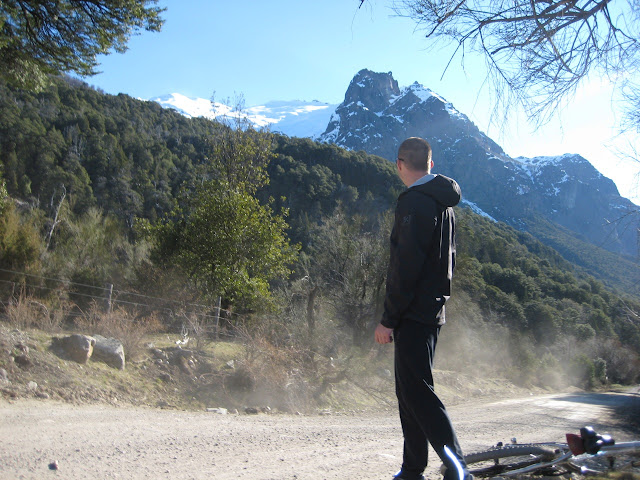Generally, rule #1 at any ski resort is don’t ski out of bounds. Of course some of the best (untouched) terrain can be off-piste or back country. But for obvious reasons, skiing or snowboarding out of bounds for most people is not a good idea. The ski resort at Volcán Villarica in Pucón, Chile has no marked boundaries.
Several skiers and snowboarders I met in Chile all said very different things about skiing in Pucón: It’s so unprotected from the wind; The snow is great; The good snow only lasts for a day or two; There is so much terrain accessible from just 1 lift; The resort is so small; It's so much fun to snowboard the natural half-pipes created by lava flows; Climb the volcano!
After being in Pucón for 4 days, my trip to the ski resort was the first time I had actually seen the volcano. On clear days, it’s a prominent backdrop to the town, but it had been raining off and on everyday of our stay. On this day the sky began to open up and the bright white cap of snow became visible from the road where we stayed.
Photo ganked from Wikipedia – much better than one I could have taken.
The drive up to the base of the volcano was about 40-minutes from the center of town, first up a smooth gradual incline, then up a steeper gravel traverse, above the snow line and to a small parking lot with less-than 30 cars. The base of the lodge was simply a ticket hut and locker rooms, with one ski lift to bring guests closer to the other lifts. Indeed, the resort is quite small in terms of accommodations. But the volcano’s peak extends to over 9,300 ft above sea level, compared to the town of Pucón at 745 ft. It’s a monster—and it’s still alive—exuding a plume of smoke that’s visible from town on clear days.
After ascending the first lift, which is over a relatively flat surface and not interesting enough to snowboard over, I met my options. The bunny slope, the intermediate slope and the best lift, which was closed! Disappointing indeed. Perhaps there was too much wind at higher elevation? Or perhaps there were not enough paying patrons to justify the use of electricity to run the lift? (Lift tickets were the equivalent of $44 USD).
I’ll admit, that my secret goal was to ride the highest ski lift and hike uphill with my snowboard until I was too tired to go further. And if I made it to the top—great. However I doubted this possibility since others told me the hike to the “big smelly hole” took about 5 hours in decent conditions with a guide who charges $70 USD. Still, the idea of ascending even halfway up the volcano to reach some serious untouched snow was very appealing.
Plan B. Take the next highest lift (seriously, it only reached terrain that was below intermediate) and hike up until I became too tired, and then snowboard down and eat lunch. Unfortunately, this other lift went up a different face of the volcano and didn’t reach the terrain I was looking for. But… whatever. I wasn’t going to waste my time on a “blue-square” run that was more like a “green circle” trail. So I ascended the lift and then hiked up the volcano… for 2 hours.
Taking a break and looking down-volcano towards the top of the ski lift.
The hike was actually interesting and challenging; the further up the ascent, the steeper the terrain. The wind became more intense. The snow became gradually more difficult to walk on. But when I finally reached the top of the face I had been climbing, my possibilities expanded. On the other side of the ridge, there were beautiful untouched bowls, twice as steep as the side I had ascended. Although I was tired from the two-hour hike, it was exhilarating to reach such great and unspoiled terrain. I got a second wind and kept advancing up the ridge, out of sight from the ski lifts. The further up I went everything appeared to be getting better! Steeper slopes. Deeper snow. Untouched in every direction.
Steep drop-offs with jagged cliffs. This sight should have been a warning.
This ridge seemed to never end and beckoned me further and further up-volcano.
Look! That’s volcano smoke spewing out of the top. New snow and no tracks in sight!
The further I ascended this wicked ridge, the wind blew stronger in intensity.
After a two-hour hike, I say to myself—“I need to make this one worth it…” So down I go on this fresh untouched snow, on terrain as steep as the top of West Face at Squaw Valley (minus the skier bumps and ice humps). I glide down quite fast—the snow has a layer of crust on top that gives nicely and provides a decently firm edge once you become acquainted with it. I make a few turns over to what appears to be terrain that keeps getting better. And then… Oh. Sh!t. F^ck. I abruptly slide down on my back edge over terrain that becomes so steep that I have to press hard to maintain an edge. And then… I stop. Arms extended, gripping the cliff crucifix style, over a jagged precipice that drops-off at least 300-ft down to a pristine gulley created by earlier lava flows. Obviously my original intentions were to make it down to that same gulley and back to the ski resort, but not this way—Not over a cliff! I was now in deep trouble if I lost my edge or if the snow collapsed from under my board.

Nearly meeting death, perched above a rocky cliff. There’s no way to express the altitude of the terrain with this photo, but I do not lie when suggesting the drop-off here is at least 300 ft.
In between periodic digging into the snow with my hands, trying to make a ledge where I can maintain a seat if the snow below my board falls over the cliff, I basically chill out at this point for a whole hour while I decide how I’m going to get out of this predicament. No joke, I was in serious trouble. (FYI – 311, 411 and 911 don’t work in Chile).
*
The next time you find yourself on a snowboard, doing stupid shit on the mountain, off-piste, out of bounds, and you lock in a good edge right before you fall 300-ft down a cliff, I’d recommend using this method to recover:
1. This one is so obvious. Don’t panic. People are even more stupid and dangerous to themselves when they do. Chill out for an hour or so while you assess the situation if you need to.
2. Lock in your position by carving a seat into the mountain with your hands—as deep into the snow as possible. And punch and carve several grip-points in the snow in all directions in case you lose it and begin to slide.
3. Carve a ledge at waist-level in the direction with the best possibilities for escape. I basically created a traverse where I slid on my butt, inch by inch, for 50-ft towards a part of the bowl that mellowed out in steepness.
4. Once I reached a comfortable spot with snow deep enough to carve a sturdy ledge, I was able to enter a position where I took off my snowboard. I almost threw the board down the cliff, but decided it would be okay to wedge it in the snow first and assess snow conditions overhead.
5. With snowboard off, I was able to turn my body into the mountain and kick a few holes into the snow to make a foothold good enough to climb. Then I punched holes in the snow with my fist to create additional grips in the event I lost my footing. (Good way to release some aggression—if I had any). The climb over this drop-off was slow and methodical enough that I was able to recover the snowboard by lifting it over my head and pegging it into the snow every few feet of my climb.
Path of escape. Making a ledge in the direction of more moderate terrain.
Covered ground. My snow ledge that I crept across, inch by inch.
Punch that hole. Forming grips to climb uphill.
The edge of the cliff from across the bowl where I descended in poor judgement. It would have been a fantastic run had I dropped-off a few hundred feet back.
By this stage, I was in safe territory where the steepness of the slope mellowed out. Depth and scale are difficult to perceive with this photo because everything—except the most jagged rock formations—is obscured by the bright snow. The rock formation in view is set across an immense gully originally created by lava flows.
This whole process took another hour to reach the original ridge where I began my descent. I was in no mood to chance sliding back down through a different chute, even though it was possible. So I went back over the ridge where I could descend a face in the direction of the ski lodge. After so many hours of intense hiking, kicking and punching holes into the snow, without water, I was so exhausted that the first few turns back down to the ski resort were a little wobbly. But I soon recovered when I realized that I was still on untouched powder, above the altitude of even the highest lift.
All that work for just one run on untouched powder. Was the run worth it? Hell no. Looking back, if the snow was not firmly packed with firm crust on the surface, I wouldn’t have been able to dig myself out of the cliff.
In this version of me versus the volcano—I surrender!
Last run of the day overlooking Lake Villarica in the direction of Pucón.
































